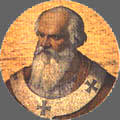 The
last pope named John was John XV. There had indeed been a man who called himself
John XVI, but he was John Philagathus the unfortunate antipope set up by
Crescentius II against Pope Gregory V. John XVII, therefore, should have been
called John XVI.
The
last pope named John was John XV. There had indeed been a man who called himself
John XVI, but he was John Philagathus the unfortunate antipope set up by
Crescentius II against Pope Gregory V. John XVII, therefore, should have been
called John XVI.
The reason why John Sicco, who became Pope Sylvester's
successor, was called John XVII is not hard to guess. Crescentius III was now
Patrician and the real power in Rome; and Crescentius III was the son of
Crescentius II who had set up antipope John XVI. Consequently, Crescentius III
would naturally insist that the pope whose election he had secured should assume
the style of John XVII. Thus his father would be saved from being publicly
branded as the supporter of an antipope.
Crescentius III dominated the papacy during this period and
carried matters with so high a hand that by one chronicle he is called "the
destroyer of the apostolic see." This however, was probably because he usurped
the popes' temporal power. As far as can be known, Crescentius III seems to have
secured the election of worthy men as popes. John XVII was a Roman named John
Sicco. Before he became a priest he had been married and had had three children,
all of whom entered the ecclesiastical state.
All that is known of his brief pontificate is that he was
consecrated on June 13, 1003, and that he died on November 6 of that same year.
John XVII was buried in the Lateran Basilica.
Excerpted from "Popes
Through the Ages" by Joseph Brusher, S.J.

